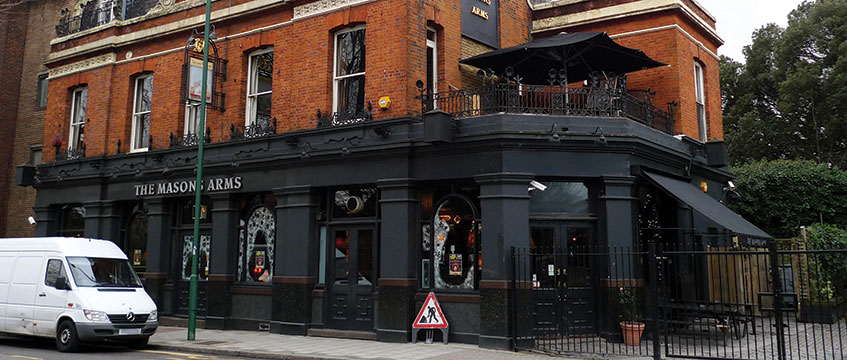The arrival of railways in Victorian England did not meet with universal approbation. Each new line had to be sanctioned by parliament and almost all railway construction was contested in one way or another. The Land Clauses Consolidation Act 1845 balanced the competing interests of landowners and companies acquiring land for railway development by obliging such companies to retain land needed for statutory purposes and to dispose of any surplus (failing which surplus land would vest in adjoining owners).
Thus, the seeds were sown for the dispute in Starham Ltd v Greene King Pubs Ltd and others [2018] PLSCS 7. The London and North Western Railway Company had been assembling land to construct a tunnel at Kensal Green in London. By a conveyance dated 24 August 1855 it transferred land, shown coloured red on the plan attached, to John Brown. In addition, it granted him, and his heirs and assigns, rights over the land coloured blue on the plan.
The railway company could not sell the blue land because it lay above the site of the new tunnel. However, it could grant rights over the surface if they did not interfere with the railway (as confirmed in the later case of British Transport Commission v Westmorland County Council [1958] AC 126). So John Brown, and his heirs and assigns, acquired the right to use the blue land “as garden ground and for agricultural purposes or for such other purposes except building as the same may be properly applied to without injury to the… tunnel”.
Public house
The Masons Arms public house, in Kensal Green, NW10, was built in late Victorian times on part of the land edged red on the plan in the 1855 conveyance. It sits beside a beer garden, created by the owners of the pub, on some of the blue land.
Title to the beer garden remained in railway company ownership until 2001 and was acquired by Starham Ltd in 2014. When Starham cried “trespass”, the owners of the public house relied on the rights granted in the 1855 conveyance.
So the question for the Central London County Court was: had the railway company granted an easement or a contractual licence? If the rights constituted an easement, the 125-year-old use of the beer garden could continue. But, if the railway company had granted a licence, the public house would lose the use of its beer garden, leaving the land ripe for development.
Rights
Unfortunately, the fact that rights are granted in a conveyance does not necessarily mean that they constitute easements. Furthermore, the draughtsman appeared uncertain about the status of the rights granted, describing them variously as an “easement”, a “limited easement or right of user”, and as a “licence”. Having rejected a suggestion that the court should construe the right as an easement in order to uphold the bargain, and after considering the language in the round, the judge decided that the railway company had intended to grant a licence.
Key points
■ The court need not construe a contractual right as an easement in order to uphold a bargain
■ In a tie-break situation, the court may conclude that a right is contractual, as opposed to being a property interest
■ The parties to a conveyance had created contractual rights over land, as opposed to a property interest that survives changes in ownership
It seems that the rights would not have qualified as easements anyway. The right to the recreational use of a garden was not established as an easement until Re Ellenborough Park [1955] 166 EG 628. So HHJ Parfitt interpreted the right to use the blue land as garden ground, and for agriculture, as a right to grow produce. He considered that this had the characteristics of a licence for exclusive occupation of the surface.
This did not render ownership of the blue land illusory, thanks to the use of the tunnel space below, but the right did not sufficiently resemble other rights commonly recognised as easements. There were no previous cases in which rights to grow produce had been recognised as easements and, if a right to cultivate is not an easement, the judge did not consider that a wider right to use the land for “other purposes except building” should qualify as an easement either.
In addition, the rights granted were not linked to, or expressed to be for the benefit of, the land on which the Masons Arms now stood. The rule that an easement cannot exist in gross would not have been fatal, had it been plain that the public house land was the dominant tenement. However, the fact that the 1855 conveyance dealt with both the red and the blue land was insufficient to connect them. And nothing indicated that the rights were attached to the public house land.
Restrictive covenant
The owners of the public house tried to persuade the judge that Starham was bound by their rights, as successors in title to John Brown, through the implication of a restrictive covenant preventing Starham from interfering with their use of the beer garden. But there was a hole in this argument. A restrictive covenant must touch and concern land held by those seeking to enforce it and the judge had decided that the rights over the blue land were freestanding. Furthermore, in Ashburn Anstalt v Arnold [1987] 2 EGLR 71 the Court of Appeal indicated that a contractual licence would not run with land unless the facts gave rise to a constructive trust. It would be absurd if that principle could be overridden by turning a contractual licence into a restrictive covenant.
Consequences
The parties to the 1855 conveyance had created contractual rights over the blue land, as opposed to a property interest that survived changes in its ownership. This meant that the owners of the public house were trespassing on, and would have to vacate, the beer garden, and were liable for damages until they did so.
Allyson Colby is a property law consultant








